Bettas attract and fascinate hobbyists of all ages simply because of their jewel-tone colors and long, delicate fins.
However, sometimes unusual can happen, and your betta fish will become to lose their color. The most common change in color is turning white or having dulled coloration.
Today we’re going to talk about the causes of why my betta fish is turning white or losing color and what you can do about it.
Let’s jump in!
How Do Betta fish Get Their Color?
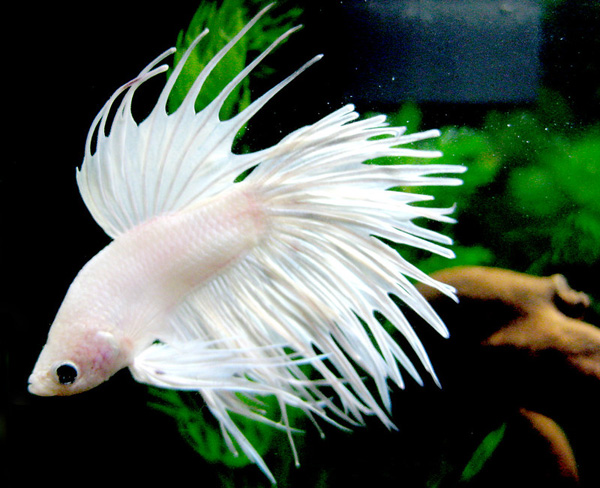
To figure out the reason why your betta is turning white, why don’t we understand why betta fish get their beautiful colors in the first place?
First, let’s start with the fact that the skin of most fish is usually white or even transparent. The actual color we perceive is due to the presence of pigment-bearing cells called chromatophores in the dermis of the fish’s skin.
More than six types of chromatophores [1] that are filled with different pigments have been described in fish, including:
- Black or brown Melanophores
- Blue Cyanophores
- Yellow Xanthophores
- Red Erythrophores
- White leucophores
- Iridescent, metallic Iridophores (or guanophores)
Mature chromatophores are grouped into clusters based on the type of pigments they contain, which lead to various shapes or structures. The colors we see on betta fish are a combination of these groups.
Studies [2] have shown that the more red erythrophores (containing reddish pigments) betta fish have, the stronger their immune systems will be. Furthermore, the number of Red erythrophores has been linked to reproductive success (RPS) as dark red males are considered more attractive than light red ones to females.
Another interesting fact is that the majority of iridescent or metallic colors on your betta’s skin come from iridophores’ location (layer) within the fish’s skin.
Chromophores are principally determined by genetics, but many factors can play a role in the color of skin in bettas.
Additional factors may include:
Natural source of the pigment: Since fish can’t synthesize their own color pigment, they must absorb them from their diet, which means bettas need to consume amounts of the right type of biochromes (biological pigments) to maintain vibrant colors, especially the melanin and carotenoids.
Hormones: In response to a change in environment, like temperature, lighting, water quality, or aquarium background, betta fish and other teleosts can directly control the pigment inside their chromatophores through the nervous and hormonal system, resulting in an apparent color change.
Social Interactions: Similarly, social interactions with other betta fish can also cause rapid changes in colors. This is why they are sometimes called “aggressive colors” because the betta shows its color as a warning sign to potential rivals or predators.
Paint or Dye: You may have heard of or seen “painted fish” or “dyed fish” sold at the local aquarium store. As the name implies, these betta fish are painted or dyed by unscrupulous dealers with synthetic pigments or hormones to make them look unique and attractive.
Unlike biological pigments from living plants or animals that can be absorbed as part of a betta’s diet, the synthetic pigments used to dye or paint fish are injected under their skin and cannot be broken down by their digestive system. As a result, the colors will eventually fade, and your betta fish will resume their natural color.
Why Is My Betta Fish Losing Color or Turning White?
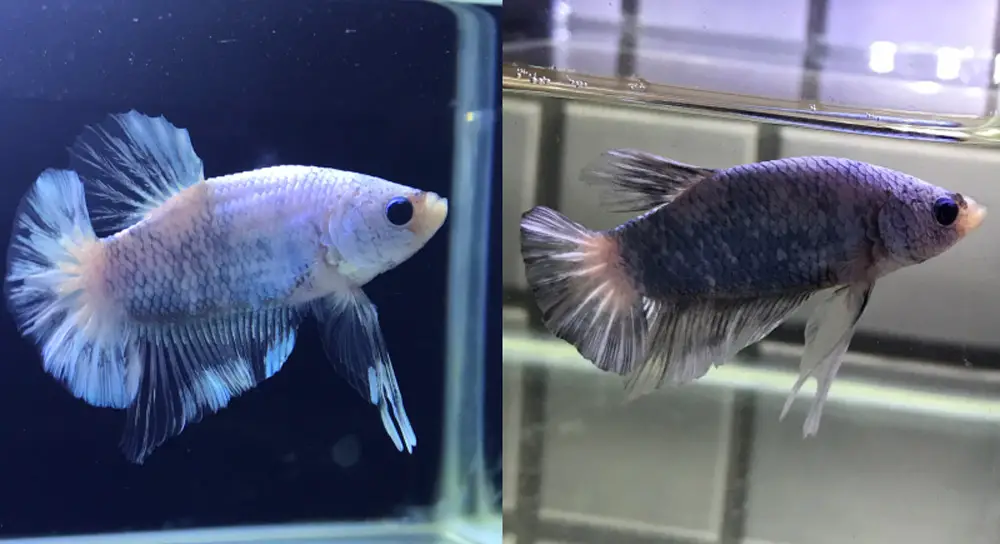
This isn’t a question with an easy answer after reading through the list above. I’ll say in some cases, the loss or changing of colors is more common than you’d think.
Along with many “natural” causes, there are other factors that increase the likelihood of color loss or turning white.
Natural Causes
Let’s face it: At the end of the day, bettas are living creatures and age like any other organism. As they get older, their colors may start to fade or change. When this happens, you won’t need to worry about it too much.
Genetics
As mentioned above, genetics determine the color of the skin. With a certain genetic background, your betta may turn white or lose its color over time simply due to natural biological processes. You can’t do much about this, unfortunately. Only buying well-maintained fish from a reputable source or breeding your betta fish yourself is a good practice.
Reproduction
It is not uncommon for bettas to change color when they enter breeding mode. As part of this process, males become more colorful for the purpose of attracting female bettas.
Old Age
Unfortunately, your betta’s colors will start fading when they enter into their twilight years due to the chromatophores becoming less dense. Normally, a betta lives for a maximum of five years. It might start to lose some of its colorings and begin to fade, usually around three years old.
A Marble Betta
Marble Bettas are known to change colors at times. As long as you have ruled out any of the above causes for the color change, you shouldn’t need to worry.
Causes Related to the Environment

Your betta will lose its color from time to time when it lacks essential pigments, inhibits chromatophores development, or is due to a variety of environmental issues.
Stress
Just like humans, fish can be negatively impacted by stress. Stress can come from poor water quality, overcrowding, injuries, handling and shipping, and improper water chemistry. Stress for fish is a serious problem that can lead to illnesses, loss of color, and, eventually, death.
Diet
The most common cause of color loss in betta fish is a poor diet. Many aquarists are unaware of the importance of monitoring their fish’s betta diet – often feeding expired or low-quality feed with inadequate pigments.
Ensure you provide your betta with a balanced, varied diet high in protein and color-enhancing nutrients like carotenes, xanthophylls, and chlorophylls.
Type of Substrate and Background
Bettas tend to adjust skin colors to camouflage with the environment. That’s why they may be seen turning white in a pale environment. A better idea would be to have dark gravel and black background in the tank, which will help your betta maintain its vibrant colors.
Need for Privacy
The betta fish may compete for territory when you have a “sorority” or “harem” female community tank. They will need their own hiding place to feel safe and secure. If your betta doesn’t have a suitable hideout, it can cause stress and lead to color loss or fading.
Temperature & pH Fluctuations
Is your betta fish losing color overnight? This could be due to temperature and pH fluctuations in the water. Ensure your tank is heated to an appropriate temperature and maintains a steady pH level for optimal health.
Betta Diseases That Can Cause Loss of Color or Turning White
There is a wide range of betta fish diseases that can cause color loss or turning white. Some can be more serious than others. For treatment to be successful, a visit to an aquatic veterinarian is a good idea.
Parasites
The dulled coloration or discoloration might be the symptoms of protozoa or flukes’ infestations. Most parasites invade the betta fish’s cells when new arrivals are introduced to the aquarium, including fish, snails, shrimps, or decorations.
Here are common parasites that can cause betta fish to become pale or discolored.
Ich (White Spot Disease)

Ich, or white spot disease, is the most common protozoal infestation in aquariums and ponds. It’s caused by a large, ciliated protozoan named Ichthyophthirius multifiliis in freshwater fish.
Because of its complex life cycle and rapid reproduction, this disease is highly contagious, and treatment must be provided immediately. This disease may result in a 100% mortality rate when left untreated.
You might be interested to know: What Else Causes White Spots on Fish Other Than Ich? (11 Causes with Pics!)
| Causes | Symptoms | Treatment |
|---|---|---|
| Stressed environment Failure to quarantine your new betta Using infected equipment or décor Ich tomonts attached to a fish bag | White spots that resemble grains of salt visible on skin or fins Clamped fins Fish scratching against rocks, décor, or gravel Missing scales Fish appearing lethargic Rapid respiration Gasping at the water’s surface Multiple fish died suddenly | Click here |
Velvet (Dust Disease)

Velvet, also known as “rust” or “gold dust” disease, is caused by either Piscinoodinium pilularis or Piscinoodinium limneticum in freshwater fish.
This dinoflagellate has a similar lifecycle of ich and attacks the gills and skin of betta fish, causing fine yellowish or pale powder on the skin, hence the names.
| Causes | Symptoms | Treatment |
|---|---|---|
| Failure to quarantine Stressed environment Using infected equipment or décor Ich tomonts attached to a fish bag, plants | Gold or rust-colored and velvety film on gills and body Color loss Heavy mucous secretion Gasping at the water’s surface Clamped fins Loss of appetite Labored breathing | Click here |
Flukes
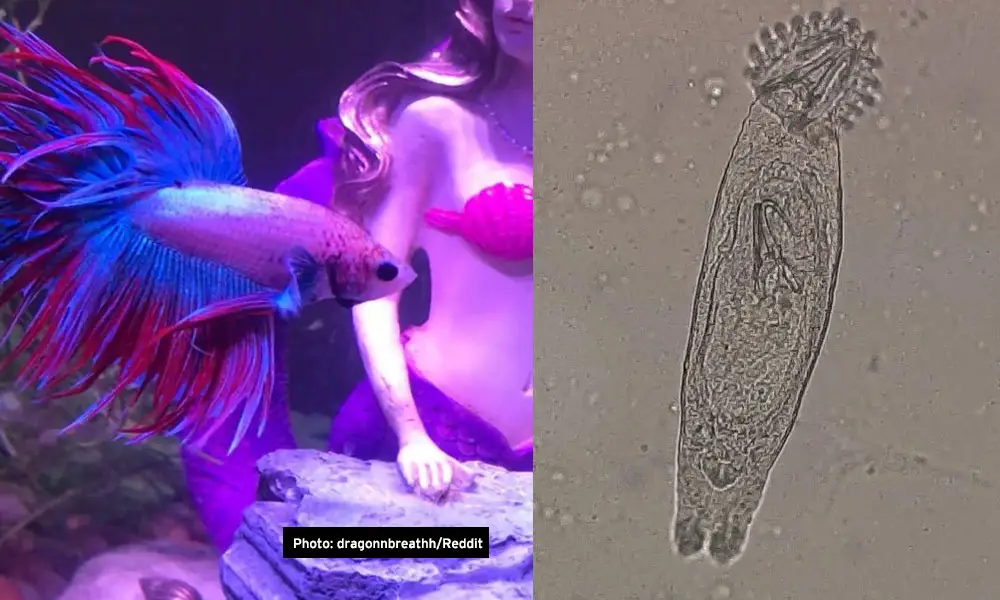
Flukes are a group of monogenean trematodes that invade the betta’s skin and gills by using a set of hooks. These microscopic parasites often cause serious damage and can lead to secondary bacterial infections.
Flukes are divided into two groups: Dactylogyrus and Gyrodactylus. The former is often present in the gills, while the latter infects the skin.
| Causes | Symptoms | Treatment |
|---|---|---|
| Skipping proper quarantine Stressed by incompatible species Poor water quality Improper diet Crowding | Missing scales and red spots on the skin Loss of color Excess mucus secretion on gills or body Scratching against objects by the affected betta fish Gills moving rapidly Flashing behavior Lethargy Decreased appetite | Praziquantel |
Ichthyobodo

Ichthyobodo necator, previously known as Costia necatrix or simply Costia, is a flagellate protozoal parasite responsible for this disease in freshwater fish.
This parasite feeds on the skin and gills of the fish, producing an excess of mucus in blue or grey colors that gives the fish a steel-grey look.
| Causes | Symptoms | Treatment |
|---|---|---|
| Skipping proper quarantine Poor water quality Stress Overfeeding Crowding | Steel-grey look Excess mucus in blue or grey on gills or body Rubbing against decorations Gasping for air Flashing behavior Lethargy Decreased appetite | Copper sulfate, formalin, or salt |
Chilodonella
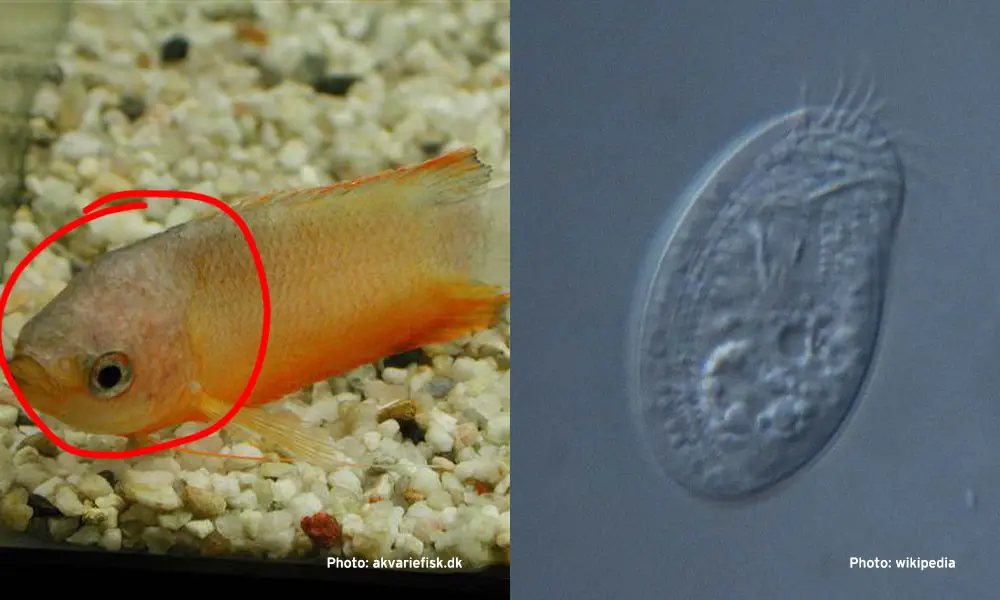
Similar to Costia, Chilodonella is another single-celled, microscopic protozoan. Two species among this genus, C. piscicolaand C. hexasticha, are known to be deadly to freshwater fish.
The clinical presentation of Chilodonella is that your betta fish appears to be covered in a gray, mottled layer on the skin.
| Causes | Symptoms | Treatment |
|---|---|---|
| Skipping proper quarantine Poor water quality Stress Overfeeding Crowding | Grey, mottled appearance on the skin Rubbing the body against decorations Increased respiration Loss of appetite Lethargy | Copper sulfate, formalin, or salt |
Bacterial Infection
From a 10-gallon male betta aquarium to a 30-gallon sorority female bettas tank, no matter your betta aquarium, there are many opportunistic bacteria that live in, on, or around your fish.
Most of the time, these bacteria are harmless until the immunity system of the betta fish is compromised, and then the bacterial infection will arise.
Like parasite infestations, several bacterial infections cause white, cloudy-looking skin on fish.
Aeromonas spp.
Aeromonas species are recognized to cause a variety of common and troublesome diseases in freshwater aquariums and ponds. All Aeromonas members are gram-negative bacteria. Among them, Aeromonas hydrophila has been considered to be the most harmful to aquatic creatures.
Often Aeromonas infections are found in warm water fish, and they mostly take advantage of fish fry or stressed fish with a compromised immune system.
Bettas infected with Aeromonas may be easily confused with other diseases and may have many different symptoms. Therefore, a diagnosis based only upon clinical signs is highly unreliable. Visit an aquatic veterinarian is strongly recommended.
Flavobacterium columnare (Columnaris)
Columnaris disease, often referred to as Cotton wool disease, Saddleback Disease, and Cotton Mouth Disease, are named for their classic clinical sign — the white cotton-like spots or patches that develops on the betta’s head, fins, or gills.
This disease is caused by warm water, gram-negative, and strictly aerobic bacterium, Flavobacterium columnare, which is often mistaken for a fungus, given its white or grey mycelial patches.
Fungal Infections (Saprolegnia spp.)
Saprolegnia is a genus of water mold that infects a broad range of fish host species. Some species of Saprolegnia are known as water mold or cotton mold for good reasons – they resemble tufts of cotton.
These fungi are well-known among fish keepers, as they cause white cotton-like lesions on the betta’s body. The infected area will appear to be fuzzy and can spread over the entire body of the betta if not treated right away.
They are often incorrectly treated as Columnaris. So, a proper diagnosis is essential for successful treatment. Saprolegnia is an opportunistic organism, meaning when the root cause (water temperature or quality) has been remedied, and any bacterial infections are treated, it will often self-heal.
Conclusion
Thankfully, your betta fish turning white or losing color does not always mean there is a larger problem. Sometimes it’s just a normal color change.
If you rule out natural causes, then it’s most likely due to a bacterial infection or parasites. You will need to diagnose the underlying issue and treat it accordingly.
It’s always best to consult with an aquatic veterinarian before you start treatment. The sooner you can identify the problem and treat it correctly, the better chances your betta will have for a quick recovery.
Have you ever experienced this situation with your bettas? Share your experience with us in the comments below.
Good luck, and take care of your fish!
Article Sources:
- How Ornamental Fishes Get Their Color [University of Florida]
- Female Mating Preferences As A Result of Coloration And Movement In Betta splendens [Lake Forest College]
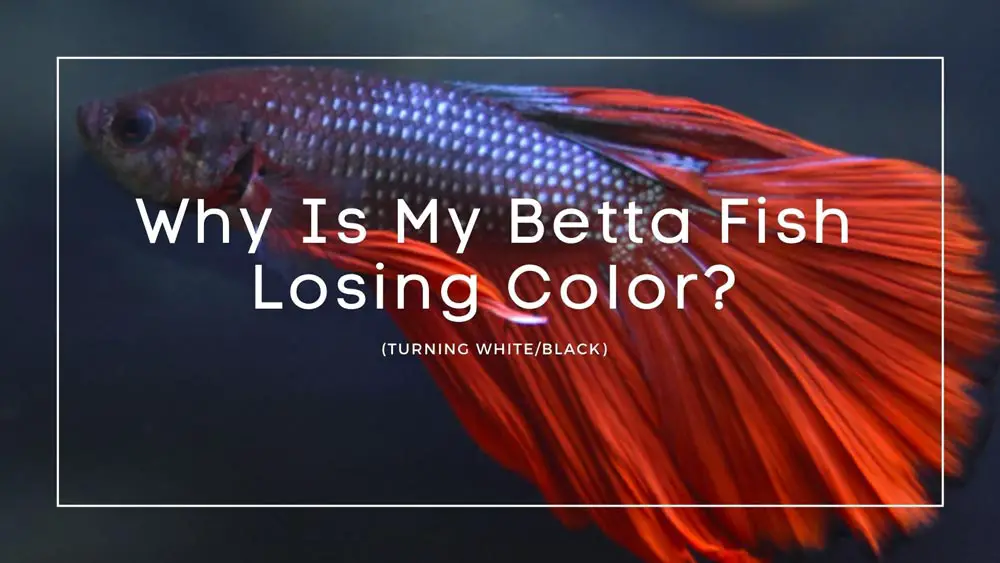
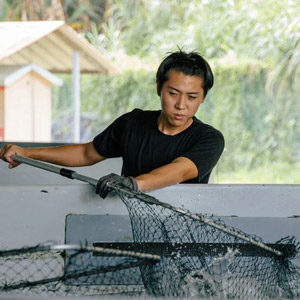




2 thoughts on “Why Is My Betta Fish Turning White or Losing Color?”
SOS
I purchased a betta about a month ago and she was happy with her guppy companions but recently she started to have little to no energy and would just float up at the surface, her color was blue and purple but know it is beige ish white and a purple body, what can I do to help
Hi Kate. Do you have any tests for your water, what are your parameters? Please give me more information about your tank such as size, filter type, number of fish in your tank.